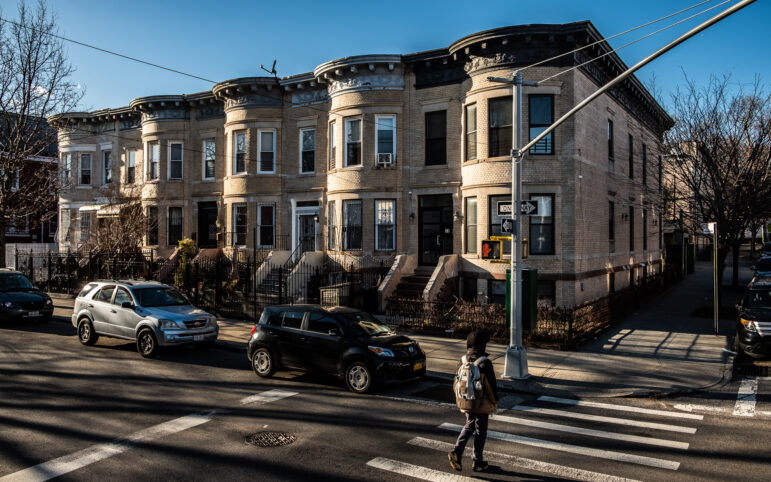
The author argues that the proposed CUNY contract is a better deal for Gov. Cuomo than for teachers or students.
These are reasons to be wary of the deal between CUNY and the PSC. First, the deal is the result of an unfair system of negotiations
Bernie Sanders is right when he says that the billionaires have rigged the political system, using their unparalleled wealth to fund Super PACs and lobbyists, to own the media that editorializes in their interests, and to establish think tanks and influential groups like the Citizens Budget Commission and The Partnership for New York that insist on “fiscal responsibility” – which keeps taxes low on the same companies that finance their operations. Governor Cuomo echoes their call for fiscal conservatism, caps on spending and maintaining modest taxes on those who have contributed large sums to his electoral campaigns, including real estate titans like Bruce Ratner, Richard Lefrak, Stephen Ross and Leon Litwin, and billionaires like the Koch brothers and Ken Langone.
So it’s not surprising that labor negotiations have also been rigged in favor of Cuomo and the moneyed interests behind him. In New York City, we see the following constraints on bargaining:
• Pattern bargaining: the mayor and the governor regularly settles contracts with the weakest union (say DC 37 or CSEA) and declare that to be the “pattern”. We’re told that demanding more would be “unfair” to other public employees.
• A 2 percent cap on the rise in state agency spending. No matter how high the increase in tax revenues, no matter what the needs of CUNY students are, no matter how severe the decline in per-student funding has been from years of austerity, the cap is rigidly imposed. And that cap sets a limit on what CUNY is willing to agree to in negotiations.
• The Taylor Law: In 1967, following a successful transit strike the previous year, one of the richest men in the country, Governor Nelson Rockefeller, instructed George Taylor to write a law to replace the ineffective Condon-Wadlin Act. Taylor was told the law needed to include harsh penalties to keep public unions from striking, penalties that the International Labor Organization later ruled are a violation of freedom of association. It seems clear the PSC would never accept contracts shaped by arbitrarily imposed spending caps if we were able to strike as Chicago and Los Angeles teachers have done.
The proposed memorandum of agreement (MOA) is the product of the strong centripetal pull of these forces towards a contract acceptable to Cuomo, one that doesn’t disturb CUNY’s contingent labor system or austerity spending.
Danger of accepting “pattern conforming” agreements
I agree with Pamela Stemberg who wrote in her Daily News op-ed:
Gov. Cuomo wins. Offering too little, too late and being praised for a breakthrough makes the public think that we have resolved the issue of equity for part-time faculty at CUNY. Mayor de Blasio wins. He will tout his progressive horn even as adjuncts remain mired in the second of his two cities. The state’s governing bodies will also claim that CUNY has addressed inequity.
Cuomo can claim he didn’t abandon his 2 percent spending cap because while the state will pay much of the costs of added adjunct office hours, it’s not paying for the 2 percent across-the-board increases. And now he, the CUNY Board of Trustees, and the leadership of the state legislature will consider the “adjunct problem” to have been solved. If squeezing more money out of Albany proved largely unsuccessful for the current fiscal year, how much more difficult will it be in the spring of 2020?
Every time we accept a contract that conforms – or nearly conforms – to the pattern imposed by people who don’t have the best interests of CUNY faculty, staff and students in mind, we signal to those outside interests that we will continue to compromise on their terms, and they will continue to take us for granted.
Disappointments in the MOA
Everyone at the PSC delegate assembly on November 7 will have wanted a fully funded contract that’s fair to the members and provides a measure of redress for those at the bottom. However, the obstacles put in our way by Cuomo, for the benefit of the business elite, has produced mixed results in the MOA. Along with real improvements, there are disappointments:
• Adjunct salaries will remain much too low, especially for a high-priced city like this one. The median monthly rent for a one-bedroom apartment in New York City is now $2980 ($35,760 a year) and will surely rise by 2022, when all adjunct lecturers (70 percent of all adjuncts) will be paid $5500 per 3-credit course. That $33,000 a year (before taxes) for teaching three classes a semester, less than New York’s median rent. Or $44,000 (before taxes) for teaching four classes a semester, of which rent would eat up 81 percent. Many adjuncts will remain in poverty.
A different view:
Opinion: Proposed CUNY Contract is a Good Deal for Students and Faculty
Public colleges in California pay their adjuncts (called lecturers) considerably more. Here in New York, colleges like Fordham University are higher salaries. By the spring of 2021, an English or History adjunct professor with seven or more years experience will be paid $8000 per course; a new adjunct will be paid $7000. (It is true that adjuncts at Fordham do not currently receive paid health insurance, but then most adjuncts at CUNY are not receiving health insurance either. We live in one of the wealthiest – and most costly – cities in the world. We can afford to pay for both high salaries and decent health care.)
Much has been made of the 71 percent increase in compensation that those at the bottom of adjunct salary schedule will receive by August 2022. But the majority of adjuncts are not at the bottom of the salary schedule. For most adjuncts, the five-year increase in the hourly rate is modest at best. For veteran adjunct lecturers, the hourly rate increase is only 2.8 percent over five years.
The bulk of the salary increases for adjuncts is to come from additional paid office hours, which has its problems. Curiously, CUNY considers the added office hours to be “productivity increases” while it’s said to be payment for work adjuncts are already doing. There are legitimate concerns about what tasks college administrations will expect adjuncts to perform. And there is the reality that many, perhaps most, adjunct professors do not actually have an office for their “office” hours.
In 2022, it will cost CUNY $44,000 to cover the salaries of adjunct lecturers teaching eight 3-credit courses for the year. This will be less than what the lowest-paid lecturer will receive and considerably less than what most full-time lecturers earn and so the economic incentive to continue hiring adjuncts to teach the majority of classes at CUNY will remain. The goal of beginning to dismantle the two-tier labor system will have eluded us.
• Nearly one thousand non-teaching adjuncts (NTAs) will not receive an equity increase. They are getting only the annual 2 percent raises, which will do little to raise their low incomes. Article 24.2(b) of the previous contract guaranteed that NTAs be paid at 60 percent of the adjunct rate, but that provision is being deleted in the MOA. These fellow CUNY workers are disproportionately women and people of color.
• 47 percent of CLTs are adjunct CLTs and will not receive the modest equity increases that full-time CLTs receive. Moreover, full-time CLTs will continue to be paid much lower salaries than those paid to lab technicians at the New York City Department of Education. A CUNY CLT with eight years experience currently receives $52,692 a year while a DoE lab technician with the same experience is paid $73,223. At the DoE, a lab tech with 22 years experience receives $93,756 a year, while CUNY pays only $65,011.
Who pays for the contract?
The PSC has long maintained that contracts should be fully funded by the state and the city. However, the governor has not agreed to pay for the across-the-board 2 percent increases. For each of the last three years, no doubt under pressure from Cuomo (his NYS Budget Director, Robert Mujica, is a CUNY Trustee), CUNY’s central office has directed college presidents to skim off approximately 2 percent of their operating budgets for a labor reserve to pay for contractual salary increases. It appears the skimming is being done this year as well. Students have suffered and continue to suffer from the cannibalization of the CUNY budgets – forcing reduced hours for tutoring centers and libraries, as well as fewer course sections and larger class size. Adjuncts are losing courses to teach, losing income and sometimes losing health insurance in the process.
While there are certainly gains in the proposed MOA, we should hesitate to call an agreement “historic” whose method of funding compromises the quality of education for CUNY students. Further, the governor’s forcing CUNY to internally finance collective bargaining agreements will undoubtedly mean further $200-a-year tuition hikes for students, at the same time their education is being degraded.
Glenn Kissack is a retiree member of the PSC who taught mathematics at Hunter College High School.









2 thoughts on “Opinion: Be Wary of the Deal Between Cuomo and CUNY’s Union”
I’m confused; this is a great article with tons of great info, but what will the adjunct rate be under the new contract? I’m an MFA candidate set to graduate in May 2020 looking to be an adjunct at CCNY…
The PSC negotiates with CUNY management, not with the governor. The contract, if ratified by the members, will direct tens of millions of new City and State dollars to CUNY every year at a time when the University is chronically underfunded. Much more is needed from both the State and the City to fully fund CUNY, and the PSC will continue to fight alongside our students and the NYC community for the new investment that CUNY deserves.
It’s true that the adjunct raises will vary based on the adjunct’s title, salary step and the number of courses they teach. And it’s true that adjuncts – like all 30,000 PSC members – should earn enough to thrive in this expensive city. But if the PSC members ratify the PSC-CUNY contract, 12,000 workers will receive an average raise of 45%, and the lowest rate of pay for a CUNY adjunct will increase by 71%. Kissack offers no analysis of how rejecting the proposed contract would lead to higher increases for CUNY adjuncts and higher pay for all. Even contracts settled after strikes and without the constraints in New York that Kissack identifies rarely achieve raises of 45%.
Also, here’s an important correction:
Nearly 70% of CUNY adjuncts are, in fact, in the lowest paid title, the Adjunct Lecturer. And the largest number of adjunct instructors receive pay based on the lowest salary step of the Adjunct Lecturer title. 30% of adjunct instructors are at the bottom step. Kissack also gets it wrong when he asserts that “for veteran adjunct lecturers the hourly rate increase is only 2.8 percent over five years.” The smallest increase in the hourly rate for an adjunct lecturer is 10.41%. But every adjunct instructor will be paid for more hours per course because of the new paid office hour. With the paid office hour, no Adjunct Lecturer teaching at least three credits will see their salary increase by less than 23% under the proposed contract.
Kissack is also too quick to concede that there will be a tuition increase at CUNY next year and that New York State will not cover all negotiated salary increases. His assumptions only normalize underfunding. Whatever the state and city governments will say about the increase for adjuncts being enough, the PSC leadership has been clear that the union’s fight for adjuncts and against austerity will continue. The proposed PSC contract with CUNY delivers substantial salary increases to thousands of low-paid workers and provides a springboard for future campaigns. That’s a contract progressives should embrace.